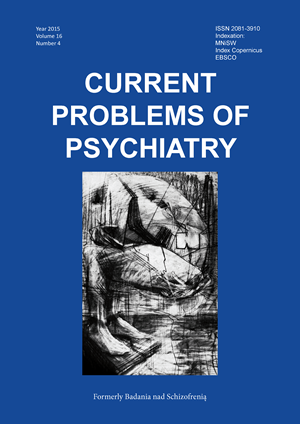Benzodiazepine dependence – the conditionsof severe course. Case report
Keywords:
benzodiazepines addiction, motivating factorsAbstract
Benzodiazepines (BDAs), synthetized for the first time by Leon Sternbach, have been in use since the early sixties and are currently appropriable in many branches of medicine. Acting on the inhibitory receptor of gamma aminobutyric acid (GABA) they enhance the influx of chloride ions into the cell, resulting in hyperpolarization of the cell membrane. By interfering with the different types of GABAergic receptors, BDAs induce various effects: anxiolytic, myorelaxant, hypnotic, anticonvulsant, sedative. Studies performed in North America and Europe on BDAs use show that it concerns 0.4-6% of general population, and their chronic use is significantly more frequent in people over 65 years of age, especially in the ones suffering from physical or mental disturbances. It is estimated that among BDA users, 26-76% take BDA chronically and 20-50% have withdrawal symptoms in case of discontinuation, even when small doses have been used. Withdrawal symptoms include anxiety, sleep and cognitive disturbances, muscle tremor, oversensitivity to stimuli, depersonalization, hallucinations, agitation and seizures. More intensive withdrawal symptoms are usually correlated with chronic use and high doses, and the drugs of short half life time.
The paper describes the case of many years’ benzodiazepine dependence, patient’s drug gaining methods, the influence on the functioning and the course of the treatment with considering motivating factors.
References
1. Wald I., Morawski J., Moskalewicz J., Sierosławski J. Wypadki a używanie substancji psychoaktywnych w Europie. Alkoh Narkom, 1991; 7: 5.
2. Schweizer E., Rickels K., Case W.G., Greenblatt D.J. Long-termtherapeutic use of benzodiazepines. II. Effects of gradual taper.Arch. Gen. Psychiatry, 1990; 47: 908–915.
3. Liebrenz M, Gehringc MT, Buadze A, Caflisch C High-dose benzodiazepine dependence: a qualitative study of patients’ percep-tion on cessation and withdrawal. BMC Psychiatry, 2015; 15: 116
4. Alessi-Severini S, Boulton JM, Enns MW, Dahl M, Collins DM, Chateau D i inni . Use of benzodiazepines and related drugs in Manitoba: a population based study. CMAJ Open. 2014; 2: e208–16.
5. Pollmann AS, Murphy AL, Bergman JC, Gardner DM Deprescribing benzodiazepines and Z drugs in community-dwelling adults: a scoping review. BMC Pharmacol Toxicol. 2015; 16: 19
6. Fang SY, Chen CY, Chang IS, Wu EC, Chang CM, Lin KM. Predictors of the incidence and discontinuation of long-term use of benzodiazepines: a population-based study. Drug Alcohol Depend. 2009; 104(1–2): 140–6
7. Lader M. Long-term anxiolytic therapy: the issue of drug with-drawal. J Clin. Psychiatr. . 1987;48(Suppl):12–6.
8. de las Cuevas C, Sanz E, de la Fuente J. Benzodiazepines: more" behavioural" addiction than dependence. Psychopharmacology. 2003;167(3):297–303.
9. Ashton H. The diagnosis and management of benzodiazepine dependence. Curr Opin Psychiatry. 2005;18(3):249–55.
10. Petitjean S, Ladewig D, Meier CR, Amrein R, Wiesbeck GA. Benzodiazepine prescribing to the Swiss adult population: results from a national survey of community pharmacies. Int Clin Psychopharmacol. 2007;22(5):292–8.
11. Basińska-Starzycka A, Jamroży A Bogusław Habrat B. Odstawianie benzodiazepin i leczenie zespołów abstynencyjnych u osób uzależnionych. Indywidualizacja postępowania w oparciu o mo-nitoring kliniczny i farmakokinetyczny. Alkoholizm i Narkomania 2009; 22(1): 75-86
12. Szelenberger Waldemar Standardy leczenia bezsenności Polskiego Towarzystwa Badań nad Snem. Sen 2006, Tom 6, Supl. A, A1–A10
13. Reeve E, To J, Hendrix I, Shakib S, Roberts MS, Wiese MD. Patient barriers to and enablers of deprescribing: a systematic review. Drugs Aging. 2013;30:793–807.
14. Cook JM, Biyanova T, Masci C, Coyne JC. Older patient perspectives on long-term anxiolytic benzodiazepine use and discontinu-ation: a qualitative study. J Gen Intern Med. 2007; 22:1094–100.
15. Parran T. Jr. Prescription drug abuse. A question of balance.Med. Clin. North Am. 1997; 81: 967–978
16. Svitek J, Heberlein A, Bleich S, Wiltfang J, Kornhuber J, Hillemacher T. Extensive craving in high dose zolpidem dependency. Prog Neuropsychopharmacol Biol Psychiatry. 2008; 15;32(2):591-2.
17. Hajak G, Müller WE, Wittchen HU, Pittrow D, Kirch W. Abuse and dependence potential for the non-benzodiazepine hypnotics zolpidem and zopiclone: a review of case reports and epidemiological data. Addiction. 2003; 98(10):1371-8.
18. Harris JT, Roache JD, Thornton JE. A role for valproate in the treatment of sedative hypnotic withdrawal and for relapse prevention. Alcoh Alcoholism 2000; 35: 319-.323.
19. Ries RK, Roy-Byrne PP, Ward NG, Neppe V, Culisson S. Carbamazepine treatment for benzodiazepine withdrawal. American Journal of Psychiatry, 1989; 146: 536-537.
20. Schweizer E, Rickels K, Case WG, Greenblatt DJ. Carbamazepine treatment in patients discontinuing long-term benzodiazepine therapy. Effects on withdrawal severity and outcome. Archives of General Psychiatry, 1991; 48: 448-452
21. Wichniak A, Wierzbicka A., Jernajczyk W. Zasady rozpoznawania i leczenia bezsenności. Psychiatr Prakt Klin, 2008; 1(1): 30-39.


